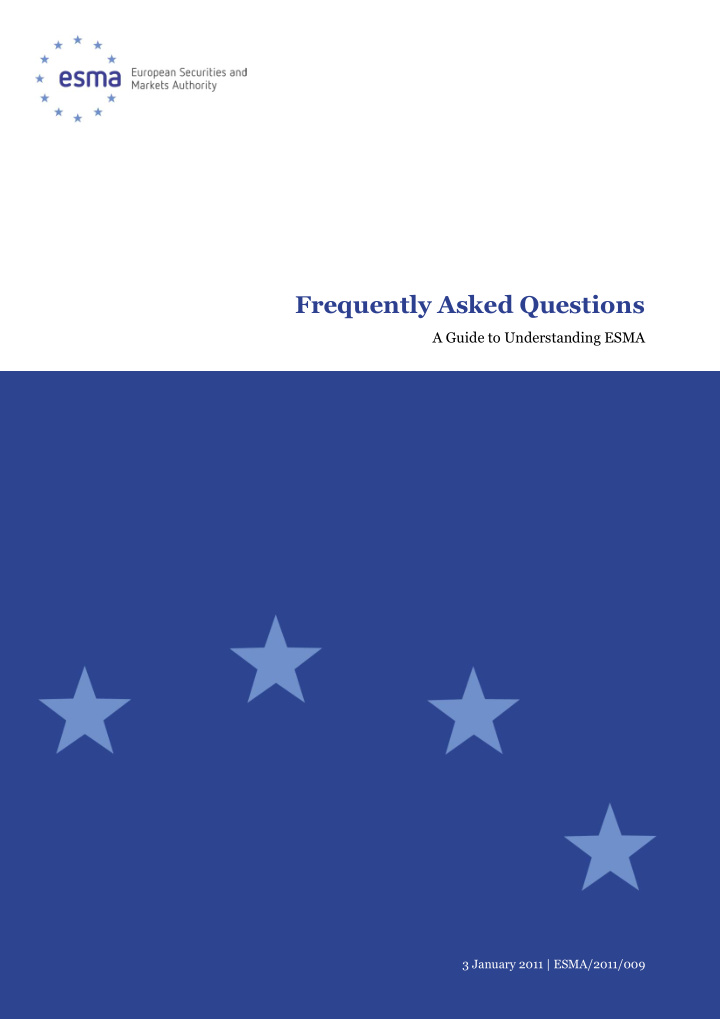



Frequently Asked Questions A Guide to Understanding ESMA 3 January 2011 | ESMA/2011/009
Date: 3 January 2011 ESMA/2011/009 Table of Contents I. EXECUTIVE SUMMARY........................................................................... 3 II THE ROLE OF ESMA ................................................................................ 3 1. What is ESMA‟s role? .................................................................................................................................... 3 2. Why was ESMA created? Why have a pan-European body? ...................................................................... 3 3. What are the new competences and powers of ESMA? .............................................................................. 4 4. Drafting technical standards that are legally binding: ................................................................................ 4 5. ESMA can launch fast track procedure to ensure consistent application of EU law: ................................ 5 6. New powers in resolving disagreements between national authorities: .................................................... 6 7. Additional responsibilities for consumer protection: ................................................................................. 6 8. Emergency powers: ....................................................................................................................................... 7 9. Participating in Colleges of Supervisors and on site visits: ......................................................................... 8 10. Monitoring systemic risk of cross-border financial institutions and contributing to the work of the ESRB: ............................................................................................................................................................ 8 11. A new supervisory role: ................................................................................................................................. 8 12. In what cases can ESMA overrule national authorities? When and how can ESMA give instructions directly to individual financial institutions? ............................................................................................... 9 III THE GOVERNANCE OF ESMA ................................................................. 9 13. Who will lead ESMA and how will they be recruited? ................................................................................. 9 14. What, generally, is the role of the Chair and the Executive Director of ESMA? ...................................... 10 15. ESMA‟s governance structure: .................................................................................................................... 10 16. To whom is ESMA accountable? ................................................................................................................ 11 17. Is there a possibility to appeal decisions by ESMA? .................................................................................. 12 18. How will ESMA consult with stakeholders? .............................................................................................. 12 IV ESMA’S BUDGET AND RE SOURCES ........................................................ 13 19. What is ESMA‟s budget? ............................................................................................................................. 13 20. How many staff will ESMA have? ............................................................................................................... 13 V CROSS-SECTOR CO-OPERATION ............................................................. 14 21. How will the three ESAs work together? .................................................................................................... 14 Annex I: List of Standing Committees, Panels, Groups and Networks of ESMA ESMA • 11 -13 ave nue de Friedland • 75008 Paris • France • Tel. +33 (0) 1 58 36 43 21 • www.esma.europa.eu
I. Executive Summary This document is intended as an explanatory guide providing an overview of the main elements of ESMA‟s functioning. The questions and answers included here may be supplemented with further information as and when further information or queries arise and will be updated on ESMA‟s website www.esma.europa.eu. This guide is not of a legal nature and it is recommended that any queries which require legal certainty should refer to the Regulation1 establishing ESMA itself or the relevant sector legislation. The internal rules and procedures for ESMA will be adopted by the Board of Supervisors and Management Board in the course of January 2011 and will be added to the website when final. II The Role of ESMA 1. What is ESMA’s role? ESMA is an independent EU Authority that contributes to safeguarding the stability of the European Union‟s fina ncial system by ensuring the integrity, transparency, efficiency and orderly functioning of securities markets, as well as enhancing investor protection. In particular, ESMA fosters supervisory convergence both amongst securities regulators, and across financial sectors by working closely with the other European Supervisory Authorities competent in the field of banking (EBA), and insurance and occupational pensions (EIOPA). ESMA‟s work on securities legislation contributes to the development of a single rule book in Europe. This serves two purposes; firstly, it ensures the consistent treatment of investors across the Union, enabling an adequate level of protection of investors through effective regulation and supervision. Se- condly, it promotes equal conditions of competition for financial service providers. As part of its role in standard setting and reducing the scope of regulatory arbitrage, ESMA streng- thens international supervisory co-operation. Where requested in European law, ESMA undertakes the supervision of certain entities with pan-European reach. Finally, ESMA also contributes to the financial stability of the European Union, in the short, medium and long-term, through its contribution to the work of the European Systemic Risk Board, which iden- tifies potential risks to the financial system and provides advice to diminish possible threats to the fi- nancial stability of the Union. ESMA is also responsible for coordinating actions of securities supervi- sors or adopting emergency measures when a crisis situation arises. 2. Why was ESMA created? Why have a pan-European body? Following the onset of the financial crisis, Commission President Barroso summoned a high level group of experts in financial services in 2008 to advise on the future of European Financial regulation and supervision. 1 To view the Regulation establishing ESMA please visit: http://eur-lex.europa.eu/LexUriServ/LexUriServ.do?uri=OJ:L:2010:331:0084:0119:EN:PDF 3
Recommend
More recommend